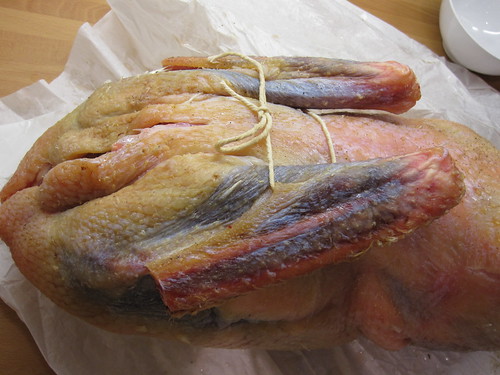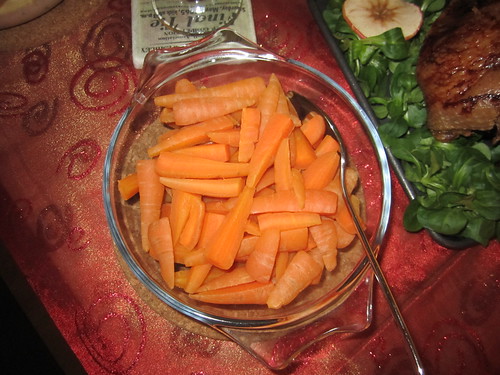I made the traditional Swedish Christmas ham yesterday - this year I got a 3 kg piece "off the bone", that had been cured and smoked and again I boiled it for some 3.5 h and left to cool overnight.
Then bright and early this morning, I removed the fat and followed my glazing recipe from a few years back.

But I also decided to make some bread together with my nieces Lou and Falbala. And it was a festive Bulgarian bread especially for such holidays. Curiously, I came across it at Foodiva's Kitchen. She's done an amazing job of translating the original recipe from Bulgarian.
I didn't need to go through that much as I can read enough Bulgarian to work things out. Foodiva's actually made some changes to the recipe. I followed the original one with regards to the ingredients, but then opted for Foodiva's method of putting the bread together.
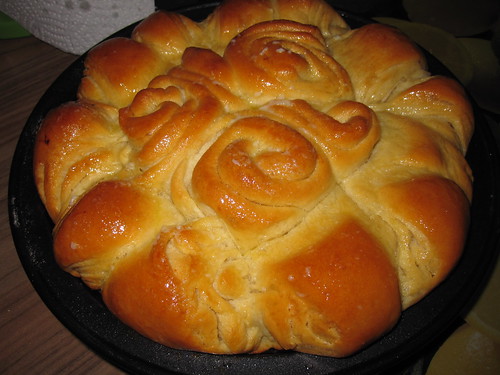
The dough was very soft and nice to work with and Lou made a fab job of rolling the pieces. Lundulph' Mum didn't have a tray big enough for the whole dough, so we ended up making two smaller breads, still they worked out very nicely.
I'll repeat the original recipe here for the sake of completeness and I'll do them in the order they are needed.
Ingredients
Pre-ferment
1 dl warm milk (about 40 degrees)
1 tbsp caster sugar (can be replaced with honey)
20 g fresh yeast
Main dough
500 g strong flour + lots more for kneading
0.5 tsp salt
2 tbsp sunflower oil
2 medium eggs + 1 egg white
0.5 tbsp cider vinegar or lemon juice
1.5 dl warm milk (about 40 degrees)
100 g unsalted butter
Egg wash
1 egg yolk
2 tbsp milk
Method
- Stir together the warm milk, caster sugar and fresh yeast and set aside to bubble up for about 10 - 15 minutes.
- In a large bowl, measure up the flour and stir in the salt.
- Make a well in the middle of the flour and add the oil, eggs, vinegar and milk.
- When the pre-ferment has bubbled up, add it as well and stir together to a very sticky dough.
- Turn out on a well floured work surface and knead the dough for about 10 minutes until it becomes smooth and elastic and gluten has developed. Add more flour if needed, but in smaller amounts so as not to add too much.
- Flour or oil the bowl and place the dough back in there, cover and let rise to double volume, about 1 h.
- Melt the butter on low heat, making sure it doesn't start to bubble.
- Divide the dough into 8 equal parts, then roll each part to an oblong shape about 3 - 5 mm thick. You should get something like 30 x 15 cm.

- After rolling each part, brush it with melted butter, then place a second rolled out part on top and brush it with butter as well.
- Roll up along the longer side. Repeat with the remaining six parts.
- Brush a 28 cm round baking tin (2 - 3 cm deep) with butter. Or two round 20 cm tins.
- Take a roll at a time and cut off the ends, about 5 cm in. Cut the remaining roll into at an angle so that triangles are formed.
- If using one large baking tin, place all eight of the end pieces in the middle, "standing up", then arrange the triangle pieces alternatively around them. If using two smaller tins, use four end pieces and one triangle piece and place in the middle and the remaining triangles around.
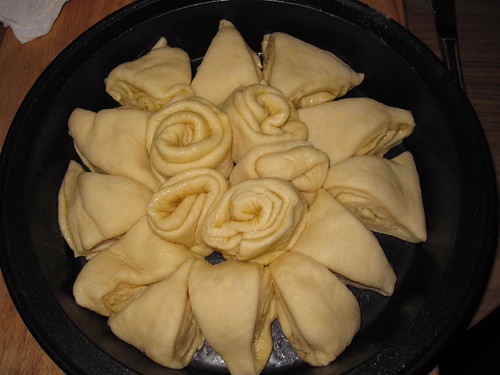
- Cover the bread and let proof for 30 - 40 minutes.
- Stir together the egg yolk and milk. Pre-heat the oven to 200 degrees C.
- Brush the bread with the egg wash and bake for 30 - 40 minutes. Cover if it starts browning too quickly.
- When it comes out of the oven, brush with the remaining melted butter, then allow to cool slightly in the tin(s) before turning out on a wire rack and letting it cool down completely.
In the end Lou did the great job of rolling out each piece. The dough was wonderful to work with, despite being borderline thick paste as I turned it out on the work surface. I suspect I used up a bit more than the 50 - 100 g additional flour stated in the original recipe and it was still slightly sticky when I placed it to rise. But it came together as if by magic and it felt like the gluten was there from the start, so reminded me a little of strudel dough in its stretchiness.

And I was quite intrigued by pre-fermenting the yeast with just milk and sugar. From my readings, if mixing sugar in a dough, it tends to "soak up" some of the liquid, thus making things dry for the yeast and inhibiting it. I was pleasantly surprised to see that in this case the yeast happily fed on the milk and sugar and swelled up to the point of almost running over the edge of the little bowl. It was just over half full when I first made the pre-ferment.
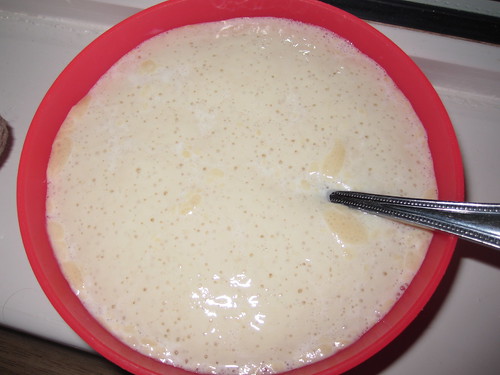
The bread is also quite neutral in flavour, so works both with sweet and savoury condiments and I do enjoy a bread that people can break up, rather than cut.
Another very interesting thing we got to observe is the importance of the colour (and the material) of the baking tin. At random, I picked two tins of equal size. But one was black and the other was silvery in colour. Both breads were baked together in my Mother-in-law's brand new oven, which still bakes evenly throughout. And yet, after 35 minutes, the bread from the black tin had more colour both top and bottom, whereas the bread from the silver tin was quite pale. I've read about this, but never actually experimented.

It's very simple - dark surfaces absorb heat better than light ones.
So we broke the bread for our Christmas dinner and had it with home made pâté and hummous and it was absolutely yummy. The texture was very light and fine and the layers in the roll came apart easily.
It occurred to me that I could potentially roll several layers very, very thinly and brush each with melted butter and shape into crescents and would have look-alike croissants. Of course I wouldn't have the same incredible number of layers and of course butter behaves differently when used solid than when used melted, but I'll definitely try it out.
As for the ham, it turned out quite nice, but was perhaps a bit over-done. I forgot to bring my meat thermometer and opted to play it safe, since I couldn't measure the core temperature of the ham. It had also remained fairly salty and was quite crumbly to cut, but was rather tasty and I believe will be very nice on sandwiches. It also looked like the stock it was cooked in would have made some very nice "dopp i grytan", but also this time I didn't get around to make the appropriate type of bread (so called vörtbröd).
Anyway, Merry Christmas to every one!


